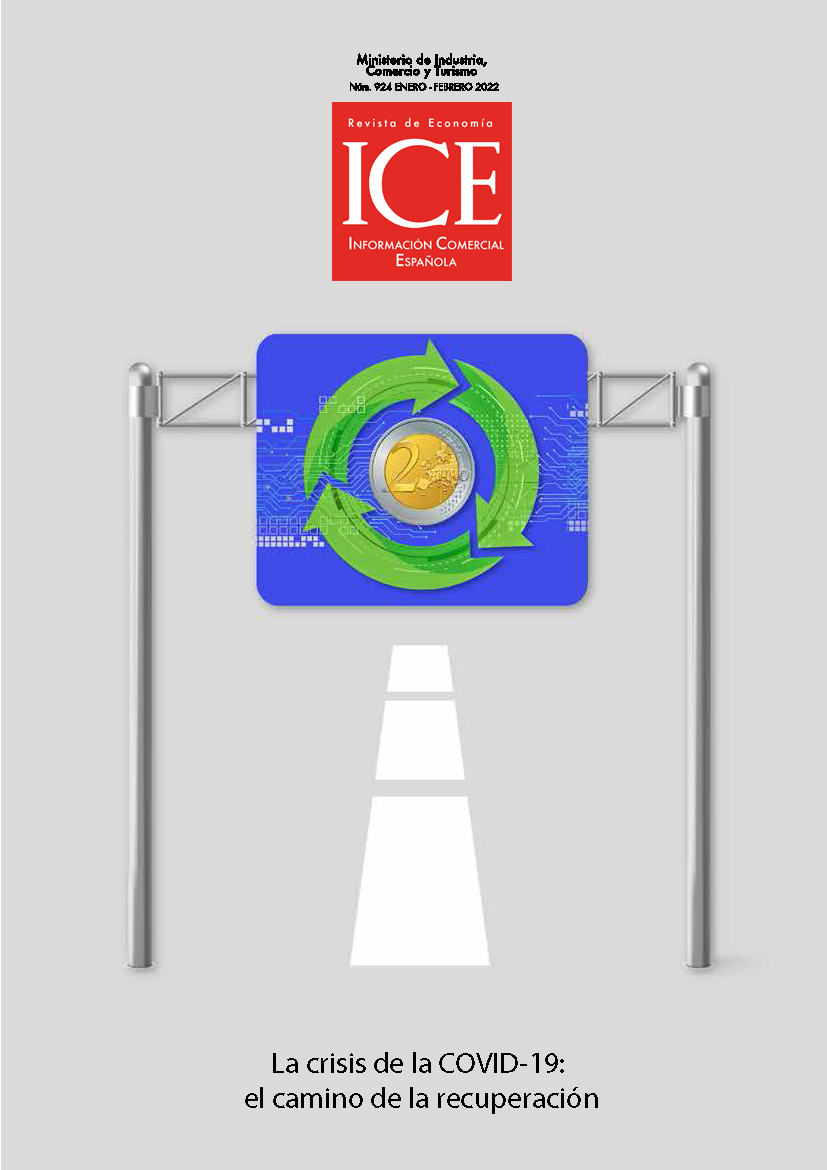Economic recovery and Spanish foreign sector, some considerations
##plugins.themes.bootstrap3.article.sidebar##
Downloads
##plugins.themes.bootstrap3.article.main##
This article reviews the changes of the last 20 years in international trade, and then analyzes the behavior of the Spanish foreign sector before, during and after the great global financial crisis (GFC) that began in 2008. Subsequently, analyzes whether during the post-crisis period, starting in 2014, there has been a change in the elasticities of the foreign sector (both Spanish and European) and whether the regulatory changes and the behavior of economic agents have translated into a behavior Spanish differential compared to our European partners that helps us to hypothesize what may happen to the foreign sector in the post-COVID-19 pandemic recovery.
##plugins.themes.bootstrap3.article.details##
- Eva Senra Díaz, Rebeca Albacete Sánchez-Mateos, Los precios de los servicios en la economía española , ICE, Revista de Economía: No. 787 (2000): Sector Servicios: desarrollos recientes y futuros desafios
- Pedro Antonio Merino García, José María Martínez Pérez, Economics and Geopolitics of Energy Sector: From Fossil Fuels to Transition Minerals , ICE, Revista de Economía: No. 935 (2024): Economía y geopolítica en un mundo en conflicto
Altomonte, C., Di Mauro, F., Ottaviano, G., Rungi, A. & Vicard, V. (2012). Global Value Chains during the Great Trade Collapse: A Bullwhip Effect? ECB, Working Paper No. 1412. January.
Antràs, P. (2020). Conceptual Aspects of Global Value Chains. World Bank Group, Policy Research Working Paper No. 9114. Washington, DC.
Arriola, C., Kowalski, P. & van Tongeren, F. (2021). The impact of COVID-19 on directions and structure of international trade. OECD, Trade Policy Papers No. 252. OECD Publishing, Paris.
Baldwin, R. (2011). 21st Century Regionalism: Filling the gap between 21st century trade and 20th century trade rules. WTO, Staff Working Paper ERSD-2011-08.
Banco de España. Informes de balanza de pagos y posición de inversión internacional. https://www.bde.es/webbde/es/estadis/infoest/temas/sb_extbppii.html
Benz, S. (2017). Services Trade costs: Tariff equivalents of services trade restrictions using gravity estimation. OECD, Trade Policy Papers No. 200. OECD Publishing, Paris.
Boz, E., Bussière, M. & Marsili, C. (2014). Recent slowdown in global trade: Cyclical or structural. VoxEU CEPR Policy. November 12.
Casella, B., Bolwijn, R., Moran, D. & Kanemoto, K. (2019). Improving the analysis of global value chains: the UNCTAD-Eora Database. UNCTAD Transnational Corporations, 26(3), 115-142.
Constantinescu, C., Mattoo, A. & Ruta, M. (2015). The Global Trade Slowdown: Cyclical or Structural? IMF, Working Paper No. 6.
Fernald, J. & Li, H. (2021). The Impact of COVID on Potential Output. Federal Reserve Bank of San Francisco, Working Paper Series No. 9.
Freund, C. (2009). The Trade Response to Global Downturns: Historical Evidence. World Bank, Policy Research Working Papers No. 5015.
Haugh, D., Kopoin, A., Rusticelli, E., Turner, D. & Dutu, R. (2016). Cardiac Arrest or Dizzy Spell: Why is World Trade So Weak and What can Policy Do About It? OECD, Economic Policy Papers No. 18. OECD Publishing, Paris.
Hoekman, B. (Ed.). (2015). The Global Trade Slowdown. A New Normal? VoxEU.org eBook, CEPR Press and EUI.
Koopman, R., Wang, Z. & Wei, S. J. (2014). Tracing value-added and double counting in gross exports. American Economic Review, 104(2), 459-494.
Lanz, R. & Maurer, A. (2015). Services and Global Value Chains - Some evidence on Servicification of Manufacturing and Services Networks. WTO, Working Paper ERSD 2015-03.
Lipsey, R. E. (2009). Measuring International Trade in Services. In M. Reinsdorf & M. J. Slaughter (Eds.), International Trade in Services and Intangibles in the Era of Globalization (pp. 27-70). University of Chicago Press.
Marschinski, R. & Martínez-Turégano, D. (2020). The EU´s shrinking share in global manufacturing: a value chain decomposition analysis. National Institute Economic Review, 252, R19-R32.
MINCOTUR, Ministerio de Industria, Comercio y Turismo. Informes de comercio exterior. https://comercio.gob.es/ImportacionExportacion/Informes_Estadisticas/Paginas/Informes-periodicos.aspx
Miroudot, S. (2019). Services and Manufacturing in Global Value Chains: Is the Distinction Obsolete? ADBI, Working Papers Series No. 927. https://ideas.repec.org/p/ris/adbiwp/0927.html
Razin, A. (2021). Globalization, Migration, and the Welfare State: Understanding Macroeconomic Trifecta. Palgrave-Macmillan.
Rodrik, D. (2011). The Globalization Paradox: Democracy and the Future of the World Economy. W. W. Norton & Company.
Saurav, A., Kusek, P., Kuo, R. & Viney, B. (2020). The Impact of COVID-19 on Foreign Investors: Evidence from the Quarterly Global MNE Pulse Survey for the Third Quarter of 2020. World Bank Group.
Timmer, M. P., Los, B., Stehrer, R. & de Vries, G. J. (2013). Fragmentation, incomes and jobs: an analysis of European competitiveness. Economic Policy, 28(76), 613-661.
TiVA, Trade in Value Added Database. (2018). Recuperado de la base de datos de la Organización para la Cooperación y el Desarrollo Económicos (OCDE).
UNCTAD, United Nations Conference on Trade and Development. (2020). World Investment Report 2020: International Production Beyond the Pandemic.


